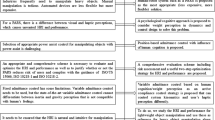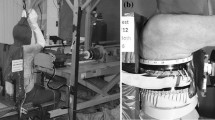Abstract
Due to the inaccurate injury assessment model of human body impact, it is hard to reasonably determine the motion speed limit of a collaborative robot in human-robot collaborative operations. In this paper, to achieve a more accurate injury assessment, an improved human-robot impact model is proposed based on equivalent mass-spring-damper model. A damper-spring structure is added between the striker and the object corresponding to ribs with mass, and human heights and weights are introduced to the model to further improve the accuracy and universality. The parameters related to mass were set to be compatible with body heights and weights, and the other parameters were identified through the particle swarm optimization algorithm. The results of the simulation show that the first segment of the improved model response is almost coincident with the test response, and almost the whole interval is improved. This study will benefit the determination of robot motion speed limit and improve the human-robot cooperation efficiency under the premise of safety in the future.















Similar content being viewed by others
References
Fréchède, B., Mcintosh, A., Grzebieta, R., Bambach, M.: Hybrid III ATD in inverted impacts: influence of impact angle on neck injury risk assessment. Ann. Biomed. Eng. 37(7), 1403 (2009)
Gierczycka, D., Watson, B., Cronin, D.: Investigation of occupant arm position and door properties on thorax kinematics in side impact crash scenarios - comparison of ATD and human models. Internat. J. Crashworth. 20(3–4), 242–269 (2015)
Goumtcha, A., Bodo, M., Taddei, L., Roth, S.: From military to civil loadings: preliminary numerical-based thorax injury criteria investigations. Internat. J. Num. Methods Biomed. Eng. 32(3), 02738 (2016)
ISO. ISO/TS 15066:2016: Robots and robotic devices-Collaboratives robots. the International Organization for Standardization, Geneva. https://www.iso.org/standard/62886.html (2016)
Kang, Y.S., Kwon, H.J., Stammen, J., Moorhouse, K., Agnew, A.M.: Biomechanical response targets of adult human ribs in frontal impacts. Ann. Biomed. Eng. 1, 49 (2020)
Kapoor, J.R., Heidenreich, P.A.: Obesity and survival in patients with heart failure and preserved systolic function: a U-shaped relationship. Am. Heart J. 159(1), 75–80 (2010)
Kroell, C. K., Schneider, D. C., Nahum, A. M.: Impact tolerance and response of the human thorax II. Proceedings of the Eighteenth Stapp Car Crash Conference (1974)
Li, P. Parametric modeling and injury analysis of occupant thorax under impact conditions concerning cariations among populations. PhD thesis, Tsinghua University, Beijing, China (2017)
Li, Z., Kindig, M.W., Subit, D., Kent, R.W.: Influence of mesh density, cortical thickness and material properties on human rib fracture prediction. Med. Eng. Phys. 32(9), 998–1008 (2010)
Lobdell, T., Kroell, C., Schneider, D., Hering, W., Nahum, A.: Impact response of the human thorax. Springer, Boston, MA (1973)
Peres, J., Christophe, B., Jesper, C., Zahra, A.: A minimum area discrepancy method (MADM) for force displacement response correlation. Comput. Methods Biomech. Biomed. Eng. 22(11), 981–996 (2019)
Richard, K., Dale, B.C., William, W., Robert, S.: The role of muscle tensing on the force-deflection response of the thorax and a reassessment of frontal impact thoracic biofidelity corridors. Proc. Instit. Mech. Eng. - Part D 220(7), 853–868 (2006)
Roth, S., Torres, F., Feuerstein, P., Karine, T.P.: Anthropometric dependence of the response of a thorax FE model under high speed loading: validation and real world accident replication. Comput. Methods Prog. Biomed. 110(2), 160–170 (2013)
Si, J., Li, J., Zhang, B., Sun, M.: Simulation analysis of passenger restraint system in coach frontal collision. China Safety Sci. J. 31(03), 135–141 (2021)
Stottmeister, A., Ramin, M.V., Schneider, J.M.: On models of blast overpressure effects to the thorax. SN Appl. Sci. 2, 2076 (2020)
Sun, T. Abdominal impact and injury mechanism analysis of a six-year-old occupant based on finite element methods. Master’s thesis, Tianjin University of Science and Technology, Tianjin, China (2015)
Vavalle, N., Davis, M., Stitzel, J., Gayzik, F.: Quantitative validation of a human body finite element model using rigid body impacts. Ann. Biomed. Eng. 43(9), 1–12 (2015)
Vavalle, N., Moreno, D.P., Rhyne, A.C., Stitzel, J.D., Gayzik, F.S.: Lateral impact validation of a geometrically accurate full body finite element model for blunt injury prediction. Ann Biomed Eng (2013)
Wu, H., Kuang, S., Hu, L.: Research on collision response of elderly occupant in autonomous vehicles. J. Mech. Eng. 12, 56 (2020)
Zhao, B.: Development of a detailed FE skull model and research on injury in vehicle traffic accidents. Master’s thesis, Jilin University, Changchun, Jilin, China (2015)
Acknowledgements
This research was supported by National Natural Science Foundation of China (Grant number U20A20282). We would like to thank Prof. Silu Chen (Ningbo Institute of Materials Technology & Engineering, Chinese Academy of Sciences) for his advice on the realization of the equivalent impact model.
Author information
Authors and Affiliations
Corresponding author
Additional information
Publisher's Note
Springer Nature remains neutral with regard to jurisdictional claims in published maps and institutional affiliations.
Rights and permissions
About this article
Cite this article
Dong, S., Pan, X. & Wang, H. An Improved Equivalent Impact Model of Human Thorax for Human-Robot Collaboration. Int J Intell Robot Appl 6, 426–436 (2022). https://doi.org/10.1007/s41315-021-00213-z
Received:
Accepted:
Published:
Issue Date:
DOI: https://doi.org/10.1007/s41315-021-00213-z




